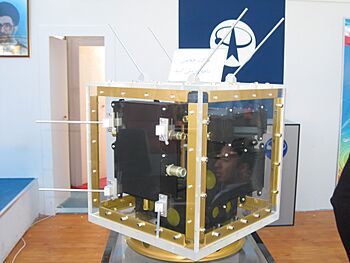Omid facts for kids
 |
|
| Operator | ISA |
|---|---|
| Spacecraft properties | |
| Launch mass | 26kg |
| Start of mission | |
| Launch date | 2 February 2009 |
| Rocket | Safir-1 |
| Launch site | Semnan |
| End of mission | |
| Deactivated | April 2009 |
| Decay date | 25 April 2009 |
| Orbital parameters | |
| Reference system | Geocentric |
| Regime | Low Earth |
| Eccentricity | 0 |
| Perigee | 258 kilometres (160 mi) |
| Apogee | 364.8 kilometres (226.7 mi) |
| Inclination | 55.5 degrees |
| Period | 90.7 minutes |
| Epoch | 2 February 2009, 13:34:00 UTC |
Omid (which means "Hope" in Persian) was Iran's very first satellite made entirely by Iran. It was a special satellite designed to process data for research and help with telecommunications. Iran's state television announced that it was successfully launched on February 2, 2009.
The satellite was sent into space by an Iranian-made carrier rocket called Safir 1. It then settled into a low Earth orbit, which is close to our planet. President Mahmoud Ahmadinejad was there to watch the launch. This event happened around the 30th anniversary of the Iranian Revolution. NASA confirmed that the launch was a success the very next day.
President Ahmadinejad said the satellite was launched to spread peace and justice. News reports also mentioned that Iran wanted its own satellites to help monitor natural disasters. Iran is a country that often experiences earthquakes. The satellite also aimed to improve the country's communication systems. Iran's foreign minister said the satellite was for peaceful purposes only.
Omid was shaped like a cube, about 40 centimeters (16 inches) on each side. It weighed about 27 kilograms (60 pounds). The satellite's main job was to collect and send data. This made Iran the ninth country in the world to be able to launch its own satellite.
Contents
What Omid Could Do
Omid was a "store and forward" satellite. This means it could receive data, save it, and then send it later to another location. It used a special frequency band called UHF for its communications.
Here are some quick facts about Omid:
- It was a store and forward telecommunication satellite.
- Its size was 40 cm × 40 cm × 40 cm.
- It weighed 27 kg.
- It used a simple way to control its temperature.
- Its orbit took about 90.7 minutes to complete one circle around Earth.
- Its orbit was tilted by 55.71 degrees.
- At its highest point (apogee), it was 381.2 km above Earth.
- At its lowest point (perigee), it was 245.5 km above Earth.
Testing the Launch
On February 4, 2008, President Ahmadinejad announced that Omid would be launched soon. This was at the opening of a new space center. Later, on August 17, 2008, Iranian officials reported they tested the satellite carrier. They even showed videos of the Safir rocket launching in the dark.
An American official later said that the rocket failed shortly after liftoff during this test. It did not reach its planned position.
Omid's Journey in Space
The Omid satellite was launched towards the southeast, over the Indian Ocean. This path helped it avoid flying over nearby countries. It settled into an orbit that was tilted by 55.5 degrees.
Its lowest point in orbit was 246 km above Earth. Its highest point was 377 km above Earth. It took about 90.76 minutes for Omid to complete one full circle around our planet.
End of Omid's Mission
Omid successfully completed its mission without any problems. It orbited Earth more than 700 times over seven weeks. According to U.S. Strategic Command, the Omid satellite came back into Earth's atmosphere on April 25, 2009. This happened over the south Atlantic Ocean, east of Buenos Aires, Argentina. No one reported seeing it re-enter. The part of the rocket that also went into orbit came back into the atmosphere later, on May 31, 2009.
Other Iranian Satellites
Omid was the second Iranian satellite to reach orbit. Before Omid, another Iranian satellite called Sina-1 was launched in 2005. Russia helped Iran build and launch Sina-1.
Iran has continued to launch more satellites. For example, Rasad 1 was launched on June 15, 2011, and orbited for three weeks.
See also
- Iranian Space Agency
- List of orbits
- Safir (rocket)
- Sina-1
- Khayyam satellite
- Timeline of first orbital launches by country

